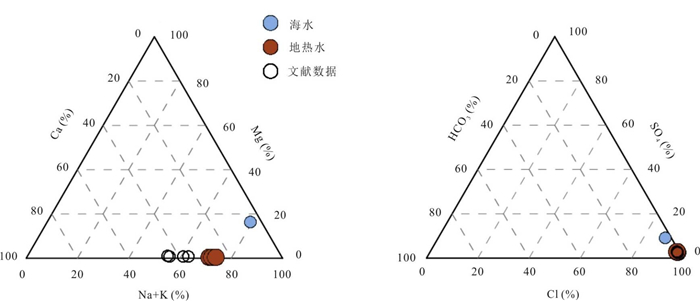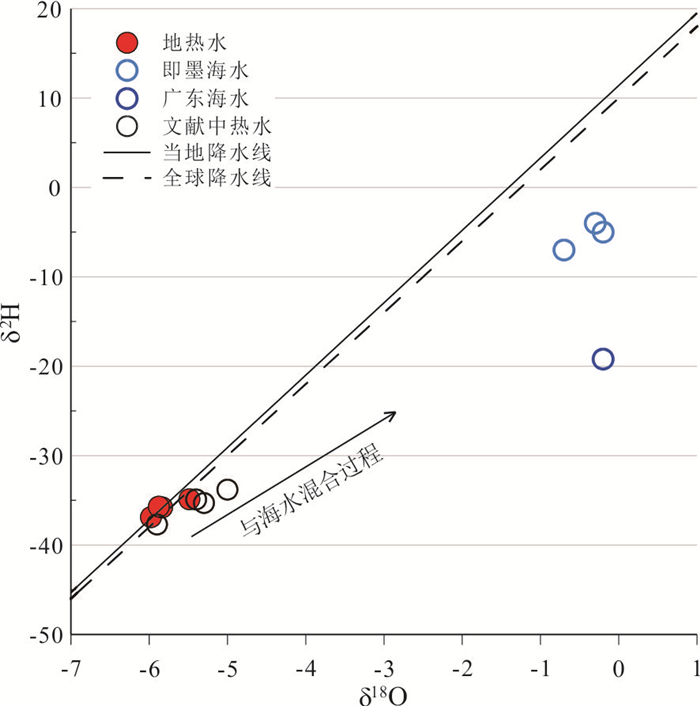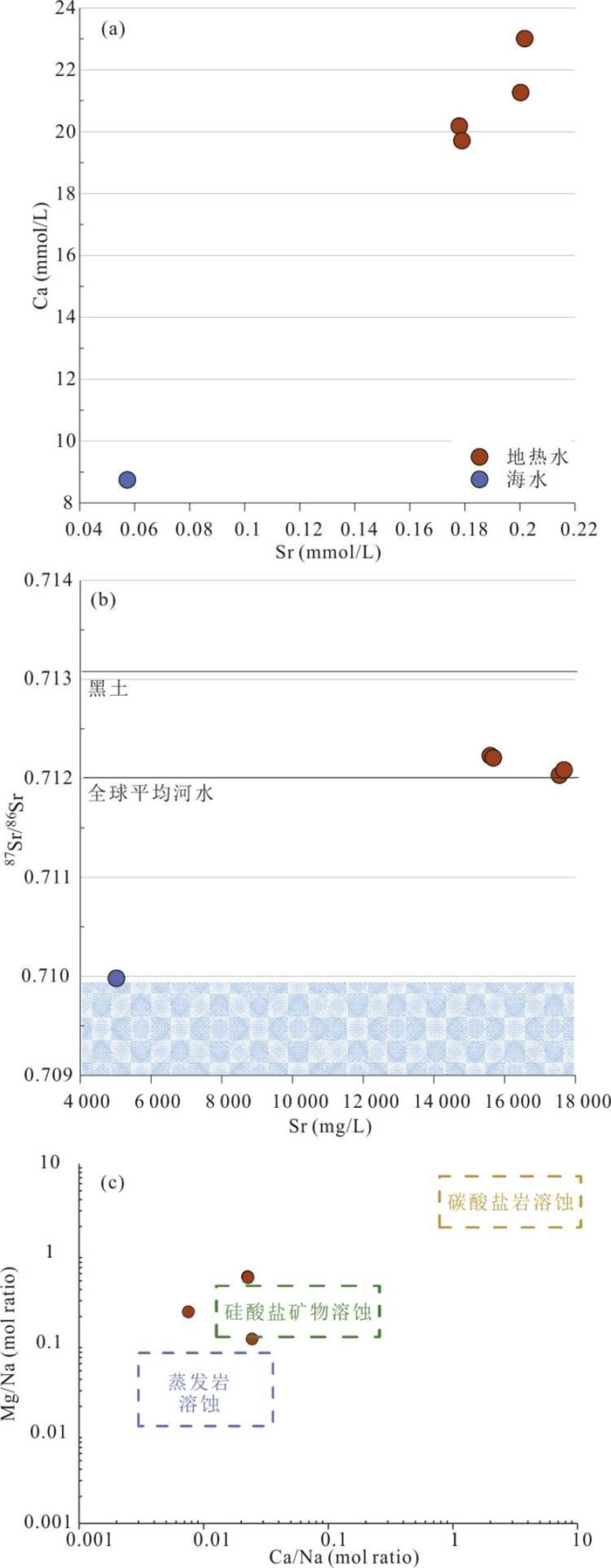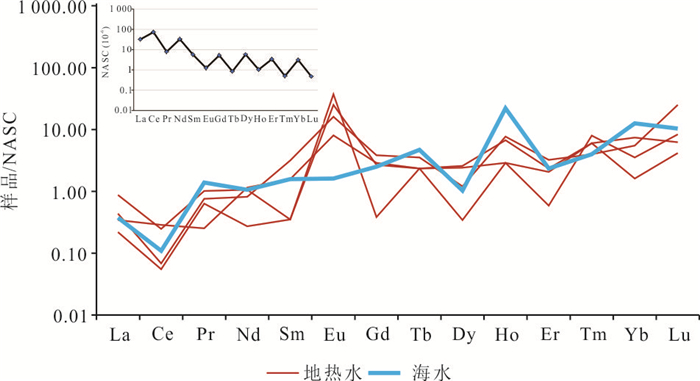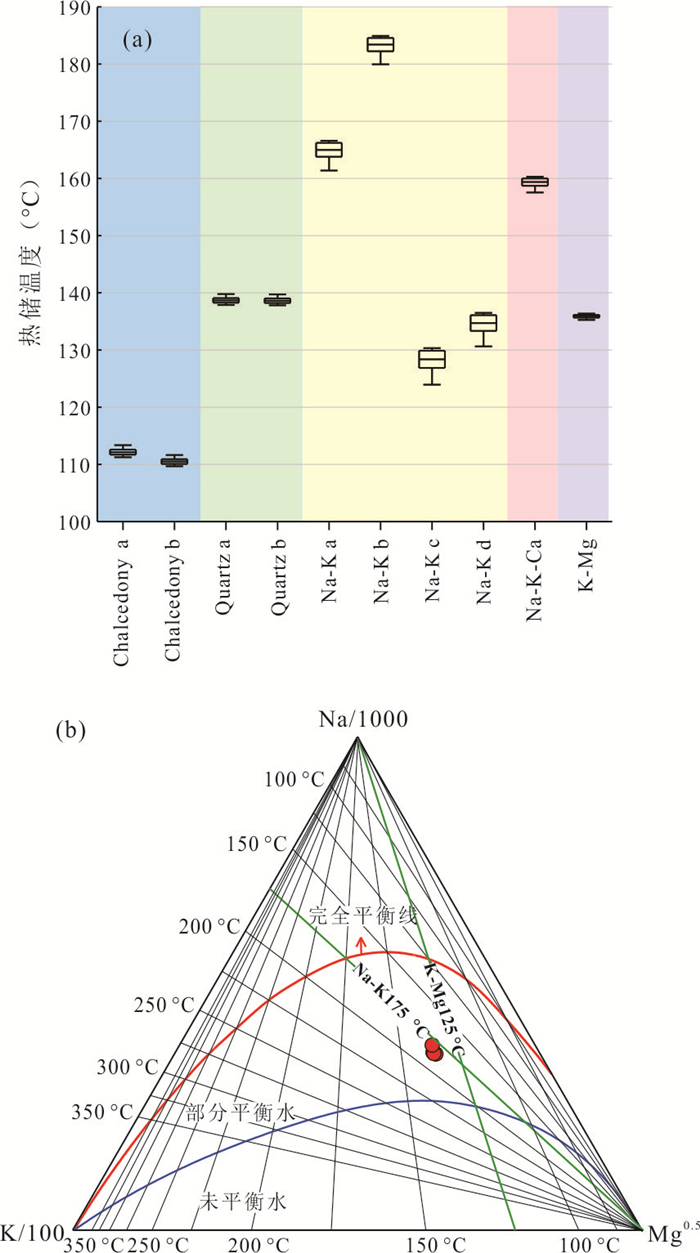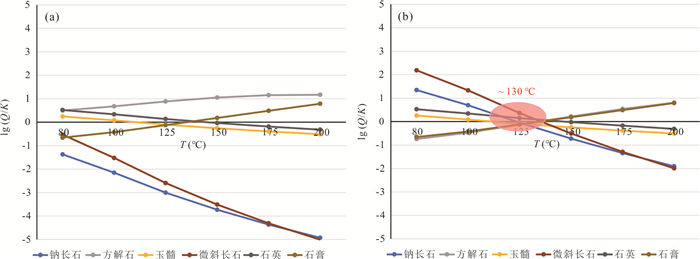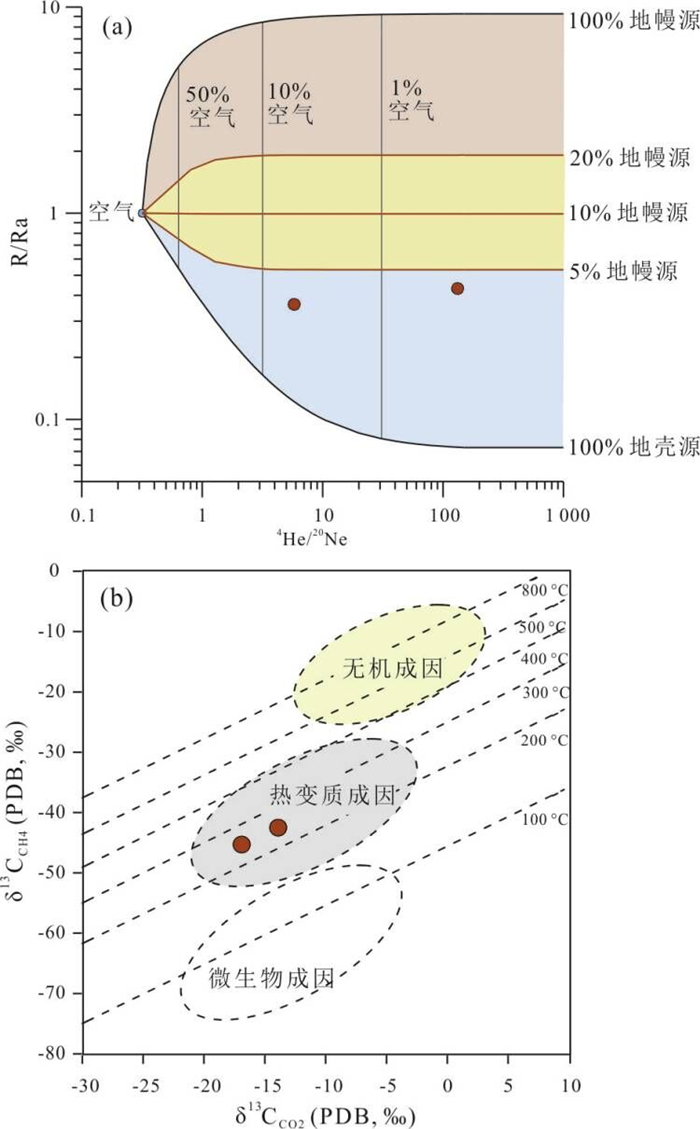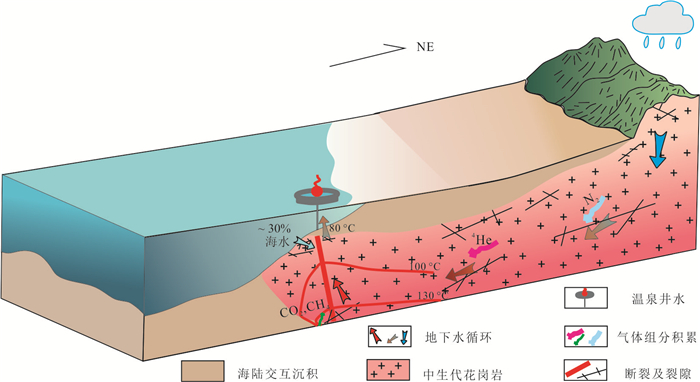Geochemical Characteristics and Circulation Conceptual Model of Geothermal Fluid in the Shenzao Coastal Hot Springs in Guangdong Province
-
摘要: 广东神灶温泉出露于海水之中,揭示其流体循环机制对地热资源的可持续开发利用具有重要意义.通过采集神灶温泉区地热水、地热气体和海水样品,测试其流体地球化学组成及主要同位素组成,得到以下认识:神灶温泉水化学类型为Cl-Na-Ca型,主要由大气降水补给;水中盐分主要来自硅酸盐矿物溶解和现代海水混入,海水混入比例为29%~32%.利用化学温度计估算热储温度为130 ℃,地热水循环深度约4 km.地热气体以大气起源N2为主要组分,CO2、CH4为壳内有机沉积物的热变质产物.此外,He同位素指示幔源组分占比不足5%,研究区大地热流值为67~69 mW/m2.综上,神灶温泉区是以壳内放射性生热为主要热源的中温对流型地热系统.Abstract: Shenzao hot springs are exposed in seawater and it is significant to reveal the circulation mechanism of geothermal fluids for the sustainable development and utilization of geothermal resources. By collecting samples of geothermal water, geothermal gas and the seawater, and testing the chemical and isotopic compositions of the samples, this study draws the following conclusions: the hot spring water is of Cl-Na-Ca type, recharged by the precipitation; the dissolved constituents are mainly derived from the dissolution of silicates and mixture with the seawater, with a mixing ratio of 29%-32%. According to the hydrochemical geothermometers, the reservoir temperature is 130 ℃, implying a circulation depth of 4 km. The atmospheric-derived N2 is the dominant component in geothermal gas and the CO2, CH4 are thermogenic products of the crustal organic sediments. In addition, the helium isotopic compositions suggest that the mantle contribution is less than 5% and the local heat flow value is about 67-69 mW/m2. Therefore, the Shenzao geothermal system is a medium-temperature convective system mainly heated by the crustal radiogenic heat source.
-
图 1 全球地热带分布(a);中国大陆东南沿海温泉分布(b)(修改自汪集旸等,1996);神灶温泉附近地形(c);神灶温泉采样点分布(d)
Fig. 1. Distribution of global geothermal belts (a); distribution of hot springs in southeast coastal of Chinese mainland (b; modified from Wang et al., 1996); topographical map of the area near the Shenzao hot spring (c); sampling sites at the Shenzao hot spring (d)
图 2 水中主要阳离子(a)、阴离子(b)相对含量三角图
文献中数据来源于Wang et al.(2018)
Fig. 2. Triangle plot of relative content of main cations (a) and ions (b) in water samples
图 3 水同位素δ2H、δ18O关系
图中即墨海水同位素数据引自Hao et al.(2020),广东海水数据引自Chen et al.(2016),地热水数据引自Wang et al.(2018),当地降水线袁建飞(2013)
Fig. 3. Plot of δ2H versus δ18O values
图 5 稀土元素NASC标准化配分图
NASC据Taylor and Mclennan(1985)
Fig. 5. NASC-normalized REE patterns for water samples in this study
表 1 水样的基本特征、主量化学组成、同位素组成及基于SiO2浓度的海水混入比例
Table 1. Major characteristics, chemical compositions and isotopic compositions of geothermal water samples, and the mixing ratios of seawater calculated based on the SiO2 contents
编号 样品类型 水温
(℃)pH TDS
(mg/L)Na
(mg/L)K
(mg/L)Mg
(mg/L)Ca
(mg/L)Cl
(mg/L)SO4
(mg/L)HCO3
(mg/L)SiO2
(mg/L)EI (%) 水化学类型 δ18O
(‰)δD
(‰)混合比
(%)SZ01 地热井 80 7.0 8 730 2 433.9 124.7 9.8 852.4 5 101.5 211.5 71.3 101.2 1.0 Cl-Na∙Ca -6.0 -36.9 0.32 SZ02 地热井 61 7.3 8 840 2 585.6 133.9 10.5 922.2 5 297.3 206.9 63.8 102.5 2.6 Cl-Na∙Ca -5.5 -34.9 0.31 SZ03 地热井 75 7.3 8 110 2 386.7 123.9 9.2 808.9 4 691.1 202.3 63.8 102.3 3.7 Cl-Na∙Ca -5.8 -35.8 0.31 SZ04 地热井 71 7.2 8 130 2 520.4 121.3 8.9 790.0 4 867.3 207.9 73.8 104.7 3.4 Cl-Na∙Ca -5.9 -35.7 0.29 SZ05 海水 26 7.8 28 200 7 594.4 272.7 831.5 350.6 13 144.0 1 821.1 635.9 12.6 0.5 Cl-Na -5.2 -17.3 0.32 表 2 水样部分微量元素、锶同位素比值、摩尔含量比值和稀土元素含量(μg/L)
Table 2. Compositions of some trace elements, molar ratios, isotopic composition of Sr and rare earth elements in water samples (μg/L)
编号 Li B Al Br Sr 87Sr/86Sr Br/Cl Na/Cl La Ce Pr Nd Sm Eu Gd Tb Dy Ho Er Tm Yb Lu SZ01 2 759 517 42.2 12 500.0 17 548.2 0.712 0 0.001 1 0.74 0.9 0.2 1.0 1.1 0.4 37.1 0.4 2.4 0.3 2.9 2.1 6.0 1.6 4.2 SZ02 2 733 479 31.6 11 944.4 17 678.3 0.712 1 0.001 0 0.75 0.2 0.1 0.6 0.3 0.4 25.0 2.7 2.4 2.4 2.9 0.6 8.0 3.5 8.3 SZ03 2 741 571 25.1 11 926.6 15 594.4 0.712 2 0.001 1 0.79 0.3 0.3 0.3 1.2 1.6 8.1 2.9 2.4 2.6 6.7 2.4 6.0 7.4 6.3 SZ04 2 724 466 20.2 11 834.9 15 679.6 0.712 2 0.001 1 0.80 0.4 0.1 0.8 0.8 3.2 16.1 3.8 3.5 1.2 7.7 3.2 4.0 5.5 25.0 SZ05 328 2 675 107.0 25 321.1 5 021.4 0.710 0 0.000 9 0.74 0.4 0.1 1.4 1.1 1.6 1.6 2.5 4.7 1.0 22.1 2.4 4.0 12.6 10.4 表 3 地热气体组分、同位素比值及相关计算
Table 3. The component and isotopic compositions of geothermal gas and correlated calculation
编号 气体组分 碳同位素 氦氖同位素及相关计算 N2
(%)CO2
(%)CH4
(%)Ar
(%)O2
(%)He
(10-6)δ13CCO2
(‰)δ13CCH4
(‰)3He/4He
(10-7)4He/20Ne R/Ra q
(mW/m2)qc/q
(%)T40 km
(±40 ℃)T50 km
(±50 ℃)SZ01 94.34 0.89 0.31 1.54 2.45 2 221 -16.9 -45.3 6.17 132 0.43 69 51.62 848 966 SZ04 79.86 0.12 0.02 0.83 19.09 120 -13.9 -42.5 5.17 5.8 0.36 67 52.83 826 941 表 4 使用地球化学温度计所得的热储温度(℃)及相应公式
Table 4. The results of reservoir temperatures and the corresponding equations
Chalcedony a Chalcedony b Quartz a Quartz b Na-K a Na-K b Na-K c Na-K d Na-K-Ca K-Mg 20SZ08 111 110 138 138 166 184 129 135 159 135 20SZ09 112 110 139 139 166 185 130 136 160 136 20SZ10 112 110 138 138 167 185 130 136 160 136 20SZ11 113 112 140 140 161 180 124 131 158 136 注:Chalcedony a相应公式为$ \frac{1\mathrm{ }032}{4.69-\mathrm{l}\mathrm{g}\mathrm{ }\left(\mathrm{S}\mathrm{i}{\mathrm{O}}_{2}\right)}-273.15 $,据Fournier(1977);Chalcedony b相应公式为$ \frac{1\mathrm{ }112}{4.91-\mathrm{l}\mathrm{g}\mathrm{ }\left(\mathrm{S}\mathrm{i}{\mathrm{O}}_{2}\right)}-273.15 $,据 Arnórsson et al.(1983) ;Quartz a相应公式为$ \frac{1\mathrm{ }309}{5.19-\mathrm{l}\mathrm{g}\mathrm{ }\left(\mathrm{S}\mathrm{i}{\mathrm{O}}_{2}\right)}-273.15 $,据Fournier(1977);Quartz b相应公式为$ \frac{1\mathrm{ }315}{5.205-\mathrm{l}\mathrm{g}\mathrm{ }\left(\mathrm{S}\mathrm{i}{\mathrm{O}}_{2}\right)}-273.15 $,据Truesdell(1976);Na-K a相应公式为$ \frac{1\mathrm{ }217}{1.483+\mathrm{l}\mathrm{g}\mathrm{ }(\mathrm{N}\mathrm{a}/\mathrm{K})}-273.15 $,据Fournier and Potter(1979);Na-K b相应公式为$ \frac{1\mathrm{ }390}{1.750+\mathrm{l}\mathrm{g}\mathrm{ }(\mathrm{N}\mathrm{a}/\mathrm{K})}-273.15 $,据Giggenbach(1988);Na-K c相应公式为$ \frac{833}{0.780+\mathrm{l}\mathrm{g}\mathrm{ }(\mathrm{N}\mathrm{a}/\mathrm{K})}-273.15 $,据Tonani(1980);Na-K d相应公式为$ \frac{933}{0.993+\mathrm{l}\mathrm{g}\mathrm{ }(\mathrm{N}\mathrm{a}/\mathrm{K})}-273.15 $,据Arnórsson et al.(1983) ;Na-K-Ca相应公式为$ \frac{1\mathrm{ }647}{\mathrm{l}\mathrm{g}\mathrm{ }(\mathrm{N}\mathrm{a}/\mathrm{K})+\beta \mathrm{l}\mathrm{g}(\mathrm{C}{a}^{0.5}/\mathrm{N}\mathrm{a})+2.24}-273.15 $,据Fournier and Truesdell(1973),单位为mol/kg,t > 100 ℃且lg(Ca0.5/Na) < 0时,β=1/3;K-Mg相应公式为$ \frac{4\mathrm{ }410}{14.0-\mathrm{l}\mathrm{g}\mathrm{ }({\mathrm{K}}^{2}/\mathrm{M}\mathrm{g})}-273.15 $,据Giggenbach(1988). 上述公式中,除特殊说明外,水化学组分浓度单位为mg/L. -
Arnórsson, S., Gunnlaugsson, E., Svavarsson, H., 1983. The Chemistry of Geothermal Waters in Iceland. Ⅱ. Mineral Equilibria and Independent Variables Controlling Water Compositions. Geochimica et Cosmochimica Acta, 47(3): 547-566 doi: 10.1016/0016-7037(83)90277-6 Chen, L. Z., Ma, T., Du, Y., et al., 2016. Hydrochemical and Isotopic (2H, 18O and 37Cl) Constraints on Evolution of Geothermal Water in Coastal Plain of Southwestern Guangdong Province, China. Journal of Volcanology and Geothermal Research, 318: 45-54. https://doi.org/10.1016/j.jvolgeores.2016.03.003 Chen, M. X., 1992. A New Map of Hot Springs in China and Its Explanation. Chinese Journal of Geology, 27(S1): 322-332 (in Chinese with English abstract). Dai, J. X., Dai, C. S., Song, Y., et al., 1994. Geochemical Characteristics and Carbon and Helium Isotopic Composition of Natural Gas in Hot Springs in some Areas of China. Science in China (Series B), 24(4): 426-433 (in Chinese). Duchkov, A. D., Rychkova, K. M., Lebedev, V. I., et al., 2010. Estimation of Heat Flow in Tuva from Data on Helium Isotopes in Thermal Mineral Springs. Russian Geology and Geophysics, 51(2): 209-219. https://doi.org/10.1016/j.rgg.2009.12.023 Fournier, R. O., 1977. Chemical Geothermometers and Mixing Models for Geothermal Systems. Geothermics, 5(1-4): 41-50. https://doi.org/10.1016/0375-6505(77)90007-4 Fournier, R. O., Truesdell, A. H., 1973. An Empirical Na-K-Ca Geothermometer for Natural Waters. Geochimica et Cosmochimica Acta, 37(5): 1255-1275. https://doi.org/10.1016/0016-7037(73)90060-4 Fournier, R. O., Potter, R. W., 1979. Magnesium Correction to the Na-K-Ca Chemical Geothermometer. Geochimica et Cosmochimica Acta, 43(9): 1543-1550. https://doi.org/10.1016/0016-7037(79)90147-9 Giggenbach, W. F., 1988. Geothermal Solute Equilibria. Derivation of Na-K-Mg-Ca Geoindicators. Geochimica et Cosmochimica Acta, 52(12): 2749-2765. https://doi.org/10.1016/0016-7037(88)90143-3 Goldberg, E. D., Koide, M., Schmitt, R. A., et al., 1963. Rare-Earth Distributions in the Marine Environment. Journal of Geophysical Research, 68(14): 4209-4217. https://doi.org/10.1029/jz068i014p04209 Guo, H. M., Zhang, B., Wang, G. C., et al., 2010. Geochemical Controls on Arsenic and Rare Earth Elements Approximately along a Groundwater Flow Path in the Shallow Aquifer of the Hetao Basin, Inner Mongolia. Chemical Geology, 270(1-4): 117-125. https://doi.org/10.1016/j.chemgeo.2009.11.010 Hao, Y. L., Pang, Z. H., Kong, Y. L., et al., 2020. Chemical and Isotopic Constraints on the Origin of Saline Waters from a Hot Spring in the Eastern Coastal Area of China. Hydrogeology Journal, 28(7): 2457-2475. https://doi.org/10.1007/s10040-020-02199-7 Hu, S. B., He, L. J., Wang, J. Y., 2000. Heat Flow in the Continental Area of China: A New Data Set. Earth and Planetary Science Letters, 179(2): 407-419. https://doi.org/10.1016/S0012-821X(00)00126-6 Jiang, G. Z., Hu, S. B., Shi, Y. Z., et al., 2019. Terrestrial Heat Flow of Continental China: Updated Dataset and Tectonic Implications. Tectonophysics, 753: 36-48. https://doi.org/10.1016/j.tecto.2019.01.006 Karakuş, H., 2015. Helium and Carbon Isotope Composition of Gas Discharges in the Simav Geothermal Field, Turkey: Implications for the Heat Source. Geothermics, 57: 213-223. https://doi.org/10.1016/j.geothermics.2015.07.005 Kuang, J., Qi, S. H., Wang, S., et al., 2020. Granite Intrusion in Huizhou, Guangdong Province and Its Geothermal Implications. Earth Science, 45(4): 1466-1480 (in Chinese with English abstract). Li, J. X., Guo, Q. H., Yu, Z. Y., 2017. Impact of Clay Mineral Formation in High-Temperature Geothermal System on Accuracy of Na-K and K-Mg Geothermometers. Earth Science, 42(1): 142-154 (in Chinese with English abstract). Ling, H. F., Shen, W. Z., Sun, T., et al., 2006. Genesis and Source Characteristics of 22 Yanshanian Granites in Guangdong Province: Study of Element and Nd-Sr Isotopes. Acta Petrologica Sinica, 22(11): 2687-2703 (in Chinese with English abstract). Luo, J., Li, Y. M., Tian, J., et al., 2022. Geochemistry of Geothermal Fluid with Implications on Circulation and Evolution in Fengshun-Tangkeng Geothermal Field, South China. Geothermics, 100: 102323. https://doi.org/10.1016/j.geothermics.2021.102323 Marty, B., Gunnlaugsson, E., Jambon, A., et al., 1991. Gas Geochemistry of Geothermal Fluids, the Hengill Area, Southwest Rift Zone of Iceland. Chemical Geology, 91(3): 207-225. https://doi.org/10.1016/0009-2541(91)90001-8 O'Nions, R. K., Oxburgh, E. R., 1983. Heat and Helium in the Earth. Nature, 306(5942): 429-431. https://doi.org/10.1038/306429a0 Pang Z. H., 1987. The Geothermal System of Zhangzhou Basin-Studies about the Genesis Model, Geothermal Potential and Distribution of Geothermal Water (Dissertation). Institute of Geology and Geophysics, Chinese Academy of Sciences, Beijing (in Chinese with English abstract). Pang, Z. H., Reed, M., 1998. Theoretical Chemical Thermometry on Geothermal Waters: Problems and Methods. Geochimica et Cosmochimica Acta, 62(6): 1083-1091 https://doi.org/10.1016/0016-7037(84)90404-6 Polyak, B., Tolstikhin, I., Yakutseni, V., 1979. The Isotopic Composition of Helium and Heat-Flow-Geochemical and Geophysical Aspects of Tectogenesis. Geotectonics, 13(5): 339-351. Reed, M., Spycher, N., 1984. Calculation of pH and Mineral Equilibria in Hydrothermal Waters with Application to Geothermometry and Studies of Boiling and Dilution. Geochimica et Cosmochimica Acta, 48(7): 1479-1492. https://doi.org/10.1016/0016-7037(84)90404-6 Sano, Y., Marty, B., 1995. Origin of Carbon in Fumarolic Gas from Island Arcs. Chemical Geology, 119(1-4): 265-274. https://doi.org/10.1016/0009-2541(94)00097-r Sano, Y., Wakita, H., 1985. Geographical Distribution of 3He/4He Ratios in Japan: Implications for Arc Tectonics and Incipient Magmatism. Journal of Geophysical Research: Solid Earth, 90(B10): 8729-8741. https://doi.org/10.1029/JB090iB10p08729 Sedlacek, A. R. C., Saltzman, M. R., Algeo, T. J., et al., 2014. 87Sr/86Sr Stratigraphy from the Early Triassic of Zal, Iran: Linking Temperature to Weathering Rates and the Tempo of Ecosystem Recovery. Geology, 42(9): 779-782. https://doi.org/10.1130/G35545.1 Taylor, S. R., McLennan, S. M., 1985. The Continental Crust: Its Composition and Evolution, An Examination of the Geochemical Record Preserved in Sedimentary Rocks. Blackwell, Oxford. Tian, J., Pang, Z. H., Liao, D., et al., 2021. Fluid Geochemistry and Its Implications on the Role of Deep Faults in the Genesis of High Temperature Systems in the Eastern Edge of the Qinghai Tibet Plateau. Applied Geochemistry, 131: 105036. https://doi.org/10.1016/j.apgeochem.2021.105036 Tonani, F. B., 1980. Some Remarks on the Application of Geochemical Techniques in Geothermal Exploration. Advances in European Geothermal Research. Springer, Dordrecht, 428-443. Truesdell, A., 1976. Summary of Section Ⅲ Geochemical Techniques in Exploration. The 2nd UN Symposium on the Development and Use of Geothermal Resources, San Francisco. Ueno, Y., Yamada, K., Yoshida, N., et al., 2006. Evidence from Fluid Inclusions for Microbial Methanogenesis in the Early Archaean Era. Nature, 440(7083): 516-519. https://doi.org/10.1038/nature04584 Wang, J. Y., Xiong, L. P., Huang, S. P., 1996. Heat Transfer and Groundwater Activity in Sedimentary Basins. Quaternary Sciences, 16(2): 147-158 (in Chinese with English abstract). Wang, X., 2018. Formation Conditions and Hydrogeochemical Characteristics of the Geothermal Water in Typical Coastal Geothermal Field with Deep Faults, Guangdong Province (Dissertation). China University of Geosciences, Wuhan (in Chinese with English abstract). Wang, X., Lu, G., Hu, B. X., 2018. Hydrogeochemical Characteristics and Geothermometry Applications of Thermal Waters in Coastal Xinzhou and Shenzao Geothermal Fields, Guangdong, China. Geofluids, 2018: 1-24. https://doi.org/10.1155/2018/8715080 Wang, Y., 1999. A Study on Mantle Heat Flow of Continental Area of China by Helium Isotope Ratio of the Underground Fluid. Acta Geoscientia Sinica, 20(Suppl. ): 48-50 (in Chinese with English abstract). Wang, Y., 2000. Estimations of the Ratio of Crust/Mantle Heat Flow Using Helium Isotope Ratio of Underground Fluid. Chinese Journal of Geophysics, 43(6): 762-770 (in Chinese with English abstract). Wang, Y. C., Li, L., Wen, H. G., et al., 2022. Geochemical Evidence for the Nonexistence of Supercritical Geothermal Fluids at the Yangbajing Geothermal Field, Southern Tibet. Journal of Hydrology, 604: 127243. https://doi.org/10.1016/j.jhydrol.2021.127243 Waples, D. W., 2001. A New Model for Heat Flow in Extensional Basins: Radiogenic Heat, Asthenospheric Heat, and the McKenzie Model. Natural Resources Research, 10(3): 227-238. https://doi.org/10.1023/A:1012521309181 Yuan, J. F., 2013. Study of the Hydrochemical Characteristics of the Coastal Geothermal Systmes in Guangdong Province (Dissertation). China University of Geosciences, Wuhan (in Chinese with English abstract). Zhang, Z. J., Wang, Y. H., 2007. Crustal Structure and Contact Relationship Revealed from Deep Seismic Sounding Data in South China. Physics of the Earth and Planetary Interiors, 165(1-2): 114-126. https://doi.org/10.1016/j.pepi.2007.08.005 Zhao, P., Wang, J. Y., Wang, J. A., et al., 1995. Characteristics of Heat Production Distribution in SE China. Acta Petrologica Sinica, 11(3): 292-305 (in Chinese with English abstract). 陈墨香, 1992. 新编中国温泉图及其说明. 地质科学, 27(S1): 322-332. https://www.cnki.com.cn/Article/CJFDTOTAL-DZKX1992S1031.htm 戴金星, 戴春森, 宋岩, 等, 1994. 中国一些地区温泉中天然气的地球化学特征及碳、氦同位素组成. 中国科学(B辑), 24(4): 426-433. https://www.cnki.com.cn/Article/CJFDTOTAL-JBXK199404013.htm 旷健, 祁士华, 王帅, 等, 2020. 广东惠州花岗岩体及其地热意义. 地球科学, 45(4): 1466-1480. doi: 10.3799/dqkx.2019.128 李洁祥, 郭清海, 余正艳, 2017. 高温地热系统中粘土矿物形成对Na-K和K-Mg地球化学温标准确性的影响. 地球科学, 42(1): 142-154. doi: 10.3799/dqkx.2017.011 凌洪飞, 沈渭洲, 孙涛, 等, 2006. 广东省22个燕山期花岗岩的源区特征及成因: 元素及Nd-Sr同位素研究. 岩石学报, 22(11): 2687-2703. https://www.cnki.com.cn/Article/CJFDTOTAL-YSXB200611006.htm 庞忠和, 1987. 漳州盆地地热系统——成因模式、热能潜力与热水分布规律的研究(博士学位论文). 北京: 中国科学院地质与地球物理研究所. 汪集旸, 熊亮萍, 黄少鹏, 1996. 沉积盆地中热的传递和地下水活动. 第四纪研究, 16(2): 147-158. https://www.cnki.com.cn/Article/CJFDTOTAL-DSJJ602.006.htm 汪啸, 2018. 广东沿海典型深大断裂带地热水系统形成条件及水文地球化学特征(博士学位论文). 武汉: 中国地质大学. 汪洋, 1999. 利用地下流体He同位素比值资料研究中国大陆地幔热流. 地质学报, 20(增刊): 48-50. https://cpfd.cnki.com.cn/Article/CPFDTOTAL-ZGDJ199910001007.htm 汪洋, 2000. 利用地下流体氦同位素比值估算大陆壳幔热流比例. 地球物理学报, 43(6): 762-770. https://www.cnki.com.cn/Article/CJFDTOTAL-DQWX200006004.htm 袁建飞, 2013. 广东沿海地热系统水文地球化学研究(博士学位论文). 武汉: 中国地质大学. 赵平, 汪集旸, 汪缉安, 等, 1995. 中国东南地区岩石生热率分布特征. 岩石学报, 11(3): 292-305 https://www.cnki.com.cn/Article/CJFDTOTAL-YSXB199503004.htm -









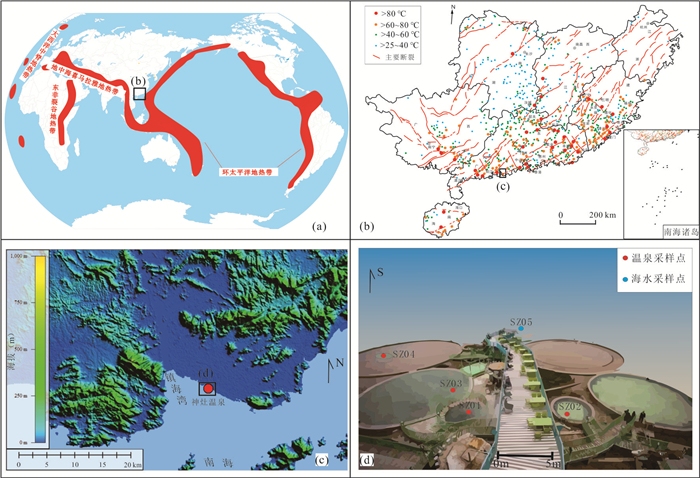
 下载:
下载:
